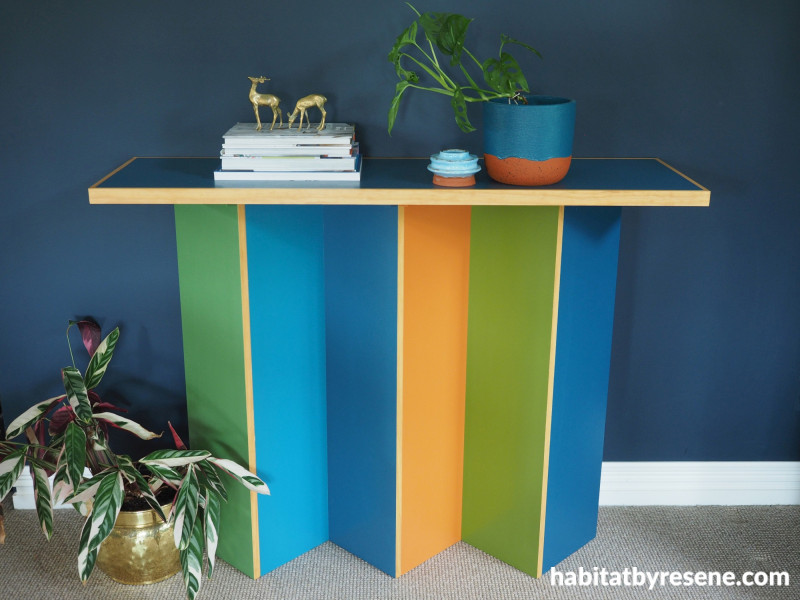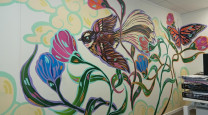
Unleash your inner colour lover with this DIY zig zag hall table
25 Jul 2023
Make your hallway look instantly more attractive with this unique DIY zig zag table. Use any Resene paint colours to match your home colour scheme, or pick your favourite vibrant shades, and add some interest and texture to your interior space.
You will need:
- 6 untreated pine boards 23cm x 18mm x 0.9m
- 1 untreated pine board 35cm x 18mm x 1.2m
- Untreated pine for blocking 24mm x 24mm x 1.8m
- Untreated pine wood trim 30cm x 10mm x 3.5m
- Mitre saw
- Pocket hole jig
- Electric drill
- Screws
- Small microfibre roller
- Cloth/rag
- Wood glue
- Painters tape
- Resene Quick Dry
- Resene Colorwood wood stain in Resene Natural
- Resene Aquaclear in a satin finish
- Resene Lustacryl testpots in paint colours of your choice. Fleur used Resene Green House, Resene Boost, Resene Time Traveller, Resene Hawaiian Tan, Resene Untamed and Resene Blue Nile. Or you could paint designs on the base with Resene testpots.

Step 1: Start by priming the six leg panels. Fleur used untreated pine boards 23cm wide, 18mm thick and 90cm long. Use a small microfibre roller to apply one coat of Resene Quick Dry. On three of the boards, leave one of the long edges unpainted. Once the primer is dry, give it a light sand with a fine grit sandpaper.

Step 2: Use a pocket hole jig to make screw holes in the back of the boards along each of the long edges. If you don’t have a pocket hole jig, when you come to assemble the base, you will need to screw the boards together by screwing in through the front face, filling the holes, sanding them flat and then proceeding with primer and paint.

Step 3: Paint the boards using your chosen Resene paint colours. Fleur used Resene Green House, Resene Boost, Resene Time Traveller, Resene Hawaiian Tan, Resene Untamed and Resene Blue Nile. Use hardwearing Resene Lustacryl paint, and again a small microfibre roller. Apply the first coat, leave this to dry, and then apply the second coat.

Step 4: Once the paint is dry, carefully sand off any paint that may have gotten on the three unpainted edges and try to get a nice crisp edge. Use a soft cloth or rag to apply two coats of Resene Colorwood Natural wood stain to the unpainted edges.

Step 5: Construct the leg base. Make sure that the boards with the unpainted edge are aligned to all be facing in the same direction. Glue two boards together with wood glue and secure them with screws from the back through the pocket holes. Proceed by attaching the remaining boards until you form the zig zag base.

Step 6: Cut, paint and screw on some blocking wood to the top of the legs. Fleur placed hers on the front and back of the two ends and in the middle.

Step 7: For the trim around the tabletop, cut it to length and then stain it with two coats of Resene Colorwood Natural.

Step 8: Cut the tabletop to size (35cm deep by 1.2m long) and prime it with Resene Quick Dry. Once this has dried, give it a light sand with a fine grit sandpaper. Paint the top with two coats of your chosen Resene paint colour using a small microfiber roller - Fleur used Resene Time Traveller. Use strong wood glue to attach the trim around the edge of the tabletop. Use painters’ tape to tape off the painted area and then apply two coats of Resene Aquaclear in a satin finish to the trim.

Step 9: To finish, position the tabletop on top and attach it by screwing through the blocking from underneath.
Wall painted in Resene Dark Knight, trims in Resene Half Rice Cake and plant pot in Resene Teal Blue and Resene Fire.
project and images Fleur Thorpe
Published: 25 Jul 2023




